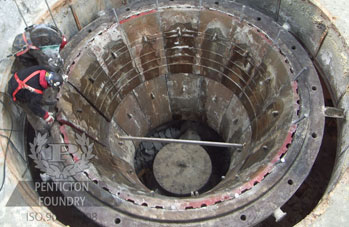ASTM A532 Class II Type D Data Sheet
on May 17, 2016W1 (20-1) Alloy
This material would be recommended for applications with a wear mechanism of abrasion and impact. Because of the lower CVF compared to the ASTM A532 Class III alloys, the abrasion resistance properties are lower but the toughness will be higher. This material has a carbide volume fraction 30%. Cr will be used up in the formation of carbides, therefore an addition of Molybdenum is important for hardenability. This material will have improved abrasion resistance compared to the 15-3 alloy.
Composition
|
|
C |
Mn |
Si |
Cr |
Mo |
|
Min% |
2.8 |
|
|
18 |
|
|
Max% |
3.1 |
1.0 |
1.5 |
25 |
1.5 |
Physical and Mechanical Properties (reference Abrasion Resistant Handbook)
|
Density lb/in3 (g/cm3) |
0.26 (7.6) |
|
Thermal Conductivity Btu/hr·ft·F (W/m·K) |
8.6-17.3 (15-30) |
|
Specific Heat at 70F Btu/lb·F (J/Kg·k) |
0.119 |
|
Coefficient of Thermal Expansion Ɛ/F(Ɛ/C)X106 average between 70-1112F |
7.2 (13) |
|
Melting Temperature (F) |
2300 F |
|
Compressive Strength Ksi (MPa) |
429 (2960) |
|
Transverse Strength Ksi( MPa) |
136 (938) |
Typical Hardness
|
|
Brinell (depends on thickness) |
|
As-Cast |
450-550 |
|
Hardened |
>650 |
Applications
This alloy meets the requirements for many applications like mining crusher liners, chute liners, crushing bars, anvils, hammers and mining crusher parts.
Corrosion Resistance
This alloy has good corrosion resistance. For a more extreme corrosion environment and abrasive wear mechanism considered using an alloy with 28-30% Cr.
Processing
This alloy is supplied in the hardened condition.
It can be machined and faced for fit purposes, but it can’t be drilled and tapped.
Inserts can be cast in if drilling and tapping is necessary.

